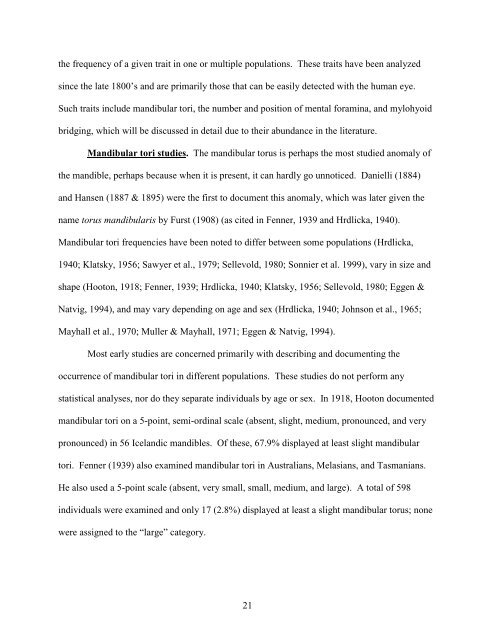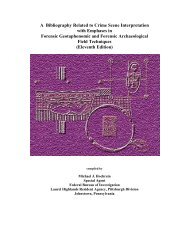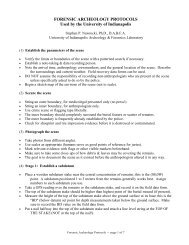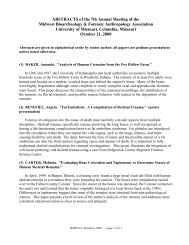Christopher W. Schmidt - University of Indianapolis Archeology ...
Christopher W. Schmidt - University of Indianapolis Archeology ...
Christopher W. Schmidt - University of Indianapolis Archeology ...
You also want an ePaper? Increase the reach of your titles
YUMPU automatically turns print PDFs into web optimized ePapers that Google loves.
the frequency <strong>of</strong> a given trait in one or multiple populations. These traits have been analyzed<br />
since the late 1800’s and are primarily those that can be easily detected with the human eye.<br />
Such traits include mandibular tori, the number and position <strong>of</strong> mental foramina, and mylohyoid<br />
bridging, which will be discussed in detail due to their abundance in the literature.<br />
Mandibular tori studies. The mandibular torus is perhaps the most studied anomaly <strong>of</strong><br />
the mandible, perhaps because when it is present, it can hardly go unnoticed. Danielli (1884)<br />
and Hansen (1887 & 1895) were the first to document this anomaly, which was later given the<br />
name torus mandibularis by Furst (1908) (as cited in Fenner, 1939 and Hrdlicka, 1940).<br />
Mandibular tori frequencies have been noted to differ between some populations (Hrdlicka,<br />
1940; Klatsky, 1956; Sawyer et al., 1979; Sellevold, 1980; Sonnier et al. 1999), vary in size and<br />
shape (Hooton, 1918; Fenner, 1939; Hrdlicka, 1940; Klatsky, 1956; Sellevold, 1980; Eggen &<br />
Natvig, 1994), and may vary depending on age and sex (Hrdlicka, 1940; Johnson et al., 1965;<br />
Mayhall et al., 1970; Muller & Mayhall, 1971; Eggen & Natvig, 1994).<br />
Most early studies are concerned primarily with describing and documenting the<br />
occurrence <strong>of</strong> mandibular tori in different populations. These studies do not perform any<br />
statistical analyses, nor do they separate individuals by age or sex. In 1918, Hooton documented<br />
mandibular tori on a 5-point, semi-ordinal scale (absent, slight, medium, pronounced, and very<br />
pronounced) in 56 Icelandic mandibles. Of these, 67.9% displayed at least slight mandibular<br />
tori. Fenner (1939) also examined mandibular tori in Australians, Melasians, and Tasmanians.<br />
He also used a 5-point scale (absent, very small, small, medium, and large). A total <strong>of</strong> 598<br />
individuals were examined and only 17 (2.8%) displayed at least a slight mandibular torus; none<br />
were assigned to the “large” category.<br />
21








